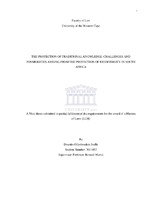| dc.description.abstract | Traditional Knowledge (TK) is the long standing wisdom, teachings and practices of indigenous communities which have been passed on orally, in the majority of cases, from generation to generation. TK is expressed in the form, medicine, agriculture, understanding of the ecology, music, dance, stories, folklore, poetry, spiritual, cultural and artistic expressions, and knowledge relating to bio-diversity. This thesis focuses on plant bio-diversity, as part of TK, and the problem of bio-piracy. We attempt a definition of TK; its characteristics; possible measures that can be taken to ensure its protection; and challenges that are likely to be faced in seeking to ensure its protection,
first at the global level, then with particular attention to South Africa. Some of the suggested measures include the enactment of sui generis laws to protect plant biodiversity, rather that the adaptation of the existing IP regime. Some of the challenges include unwillingness of some countries to participate in international initiatives, like the US, which is not even a signatory of the CBD, and the difficulty of identifying the persons in whom ownership of the TK should be vested when it is possessed by many communities. This issue is a very sensitive one because there have been numerous cases of bio-piracy in
developing countries perpetrated by corporations from industrialised countries. Some of the notable examples of bio-piracy include; The Neem tree from India whose products are used in medicine, toiletries and cosmetics; the Ayahuasca a vine used in India for religious and healing ceremonies; the Asian Turmeric plant used in cooking, cosmetics and medicine, the Hoodia Cactus plant in the Kalahari Desert of southern Africa used by the San people to stave off hunger. These instances have given rise to increased talks about the necessity of a law on the protection of TK relating to bio-diversity in general at the international, regional and national levels. The World Intellectual Property Organisation (WIPO) is working on enacting measures to
ensure the protection and conservation of TK at the international level; in 2002 it created nine fact finding commissions on TK in general. These fact finding missions on TK innovation and creativity were undertaken with the intention of seeking possibilities of protecting the intellectual property rights of TK holders. In 2002, The WIPO Intergovernmental Committee on Intellectual Property and Genetic Resources, Traditional Knowledge and Folklore (IGC) was created to continue with this task. The 1993 Convention on Biodiversity (CBD) encourages States to enact measures to implement its provisions on the protection of knowledge, innovations and practices of indigenous and local communities. This trend in protection of TK relating to biological resources has been followed by the Nagoya Protocol of October 2010. The World Trade Organisation (WTO) also makes mention of protecting
plant varieties. The research suggests that one could use both Intellectual Property Rights and Sui Generis measures to address and secure protection of TK, and provide compensation to holders for the use of the intellectual property. | en_US |

